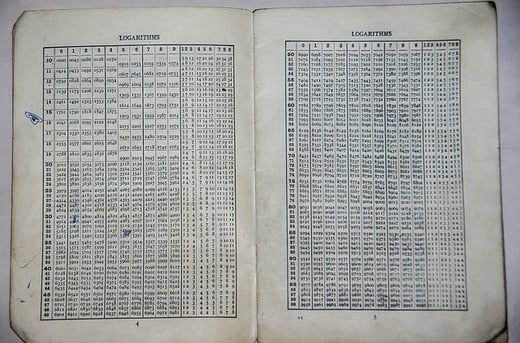How to Get Rid of E in Math
If you're taking a high school or college math class, you'll likely cover natural logs. But what are natural logs? What is ln? Why does the letter e keep showing up? Natural logs may seem difficult, but once you understand a few key natural log rules, you'll be able to easily solve even very complicated-looking problems. In this guide, we explain the four most important natural logarithm rules, discuss other natural log properties you should know, go over several examples of varying difficulty, and explain how natural logs differ from other logarithms. The natural log, or ln, is the inverse of e. The letter 'e' represents a mathematical constant also known as the natural exponent. Like π, e is a mathematical constant and has a set value. The value of e is equal to approximately 2.71828. e appears in many instances in mathematics, including scenarios about compound interest, growth equations, and decay equations. ln(x) is the time needed to grow to x, while e x is the amount of growth that has occurred after time x. Because e is used so commonly in math and economics, and people in these fields often need to take the logarithm with a base of e of a number to solve an equation or find a value, the natural log was created as a shortcut way to write and calculate log base e. The natural log simply lets people reading the problem know that you're taking the logarithm, with a base of e, of a number. So ln(x) = log e (x). As an example, ln(5) = log e (5) = 1.609. There are four main rules you need to know when working with natural logs, and you'll see each of them again and again in your math problems. Know these well because they can be confusing the first time you see them, and you want to make sure you have basic rules like these down solid before moving on to more difficult logarithm topics. In addition to the four natural logarithm rules discussed above, there are also several ln properties you need to know if you're studying natural logs. Have these memorized so you can quickly move onto the next step of the problem without wasting time trying to remember common ln properties. Scenario ln Property ln of a Negative Number The ln of a negative number is undefined ln of 0 ln(0) is undefined ln of 1 ln(1)=0 ln of Infinity ln(∞)= ∞ ln of e ln(e)=1 ln of e raised to the x power ln(e x) = x e raised to the ln power e ln(x)=x As you can see from the final three rows, ln(e)=1, and this is true even if one is raised to the power of the other. This is because the ln and e are inverse functions of each other. Now it's time to put your skills to the test and ensure you understand the ln rules by applying them to example problems. Below are three sample problems. Try to work them out on your own before reading through the explanation. Evaluate ln(72/5) First, we use the quotient rule to get: ln(72) - ln(5). Next, we use the power rule to get: 2ln(7) -ln(5). If you don't have a calculator, you can leave the equation like this, or you can calculate the natural log values: 2(1.946) - 1.609 = 3.891 - 1.609 = 2.282. Evaluate ln(e) /7 For this problem, we need to remember than ln(e)=1 This means the problem simplifies to 1/7, which is our answer Solve ln (5x-6)=2 When you have multiple variables within the ln parentheses, you want to make e the base and everything else the exponent of e. Then you'll get ln and e next to each other and, as we know from the natural log rules, e ln(x)=x. So, the equation becomes e ln(5x-6)=e 2 Since e ln(x)=x, e ln(5x-6)= 5x-6 Therefore 5x-6= e 2 Since e is a constant, you can then figure out the value of e 2, either by using the e key on your calculator or using e's estimated value of 2.718. 5x-6 =7.389 Now we'd add 6 to both sides 5x= 13.389 Finally, we'd divide both sides by 5. x= 2.678 As a reminder, a logarithm is the opposite of a power. If you take the log of a number, you're undoing the exponent. The key difference between natural logs and other logarithms is the base being used. Logarithms typically use a base of 10 (although it can be a different value, which will be specified), while natural logs will always use a base of e. This means ln(x)=log e (x) If you need to convert between logarithms and natural logs, use the following two equations: Other than the difference in the base (which is a big difference) the logarithm rules and the natural logarithm rules are the same: Logarithm Rules ln Rules log(xy)=log(x)+log(y) ln(x)(y)= ln(x)+ln(y) log(x/y)=log(x)−log(y) ln(x/y)=ln(x)−ln(y) log(x a)= alog(x) ln(x a )= aln(x) log(10x)= x ln(e x)= x 10log(x)= x e ln(x)= x The natural log, or ln, is the inverse of e. The rules of natural logs may seem counterintuitive at first, but once you learn them they're quite simple to remember and apply to practice problems. The four main ln rules are: The key difference between natural logs and other logarithms is the base being used. Writing a research paper for school but not sure what to write about? Our guide to research paper topics has over 100 topics in ten categories so you can be sure to find the perfect topic for you. Want to know the fastest and easiest ways to convert between Fahrenheit and Celsius? We've got you covered! Check out our guide to the best ways to convert Celsius to Fahrenheit (or vice versa). Taking the SAT or ACT? Students often struggle most with the Math section of these tests, but check out our comprehensive guides to SAT Math and ACT Math for everything you need to know to ace these math questions.
What Is ln?
The 4 Key Natural Log Rules
Product Rule
Quotient Rule
Reciprocal Rule
Power Rule

Key Natural Log Properties
Natural Log Sample Problems
Problem 1
Problem 2
Problem 3

How Are Natural Logs Different From Other Logarithms?
Summary: Natural Log Rules
What's Next?

About the Author
Christine graduated from Michigan State University with degrees in Environmental Biology and Geography and received her Master's from Duke University. In high school she scored in the 99th percentile on the SAT and was named a National Merit Finalist. She has taught English and biology in several countries.
Source: https://blog.prepscholar.com/natural-log-rules